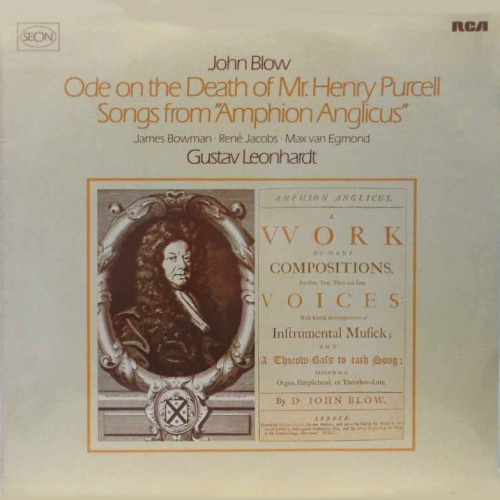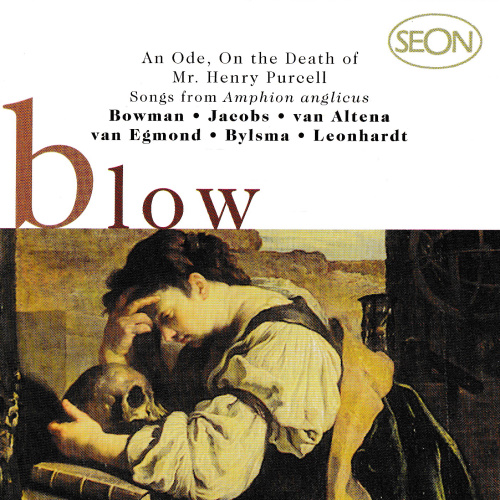 |
1 LP -
6575 016 - (p) 1974
|
 |
| 1 LP -
RL 30767 - (p) 1981 |
 |
| 1 CD -
S2K 60097 - (c) 1998 |
|
ODE &
SONGS
|
|
|
|
|
|
|
|
| John BLOW (1649-1708) |
An
Ode, on the Death of Mr. Henry Purcell
- for 2 countertenors, 2 recorders, and
continuo (cello and harpsichord)
|
|
24' 34" |
|
|
-
Mark how the Lark and linnet sing |
9' 04" |
|
A1
|
|
- So ceas'd the rival Crew when
Purcell came |
3' 06" |
|
A2
|
|
- We
beg not Hell, our Orpheus to restore
|
5' 14" |
|
A3 |
|
- The
Heav'nly Quire, who heard his Notes from
High |
7' 10" |
|
A4 |
|
Songs
from "Amphion Anglicus", London 1700 |
|
|
|
|
-
"Cloe found Amintas lying" - (A Song
for Three Voices) for 2 sopranos, bass,
and continuo (cello and Harpsichord) |
|
5' 51" |
B1 |
|
-
"Whu weeps Asteria?" - (A Single Song)
for soprano and continuo (cello and
harpsichord)
|
|
4' 22" |
B2 |
|
-
"Loving above Himself" - ("Poor
Celadon, he sighs") for contralto, 2
violins, and continuo (cello and
harpsichord) |
|
4' 08" |
B3 |
|
-
"Shepherds, Deck tour Crooks" - for
soprano, contralto, bass, and continuo
(cello and harpsichord) |
|
2' 29" |
B4 |
|
- "Ah
Heav'n! what is't I Hear?" - for
contralto, tenor, and continuo (cello
and harpsichord) |
|
3' 06" |
B5 |
|
-
Epilogue: "Sing, Sing ye Muses" - (A
song for Four Voices and Two Violins, at
an Entertainment of Musick in York
Buildings) |
|
3' 47" |
B6 |
|
|
|
|
|
An Ode, on the Death of
Mr. Henry Purcell
|
Songs from "Amphion
Anglicus"
|
|
| René Jacobs,
James Bowman, countertenors
|
Nobuko
Yamamoto, Nelly van der Speek, sopranos |
|
| Ricardo
Kanji, Marion Verbruggen, recorders |
René Jacobs,
countertenor |
|
| Anner Byslma,
baroque cello |
Marius van
Altena, tenor |
|
| Gustav
Leonhardt, harpsichordist and conductor |
Max van
Egmond, bass |
|
|
Marie
Leonharst, Antoniette van den Hombergh,
baroque violins |
|
|
Anner Byslma,
baroque cello |
|
|
Gustav
Leonhardt, harpsichordist
and conductor |
|
|
|
|
|
Luogo
e data di registrazione |
|
Doopsgezinde Kerk,
Amsterdam (Holland) - Gennaio 1973
|
|
|
Registrazione:
live / studio
|
|
studio |
|
|
Producer /
Recording Supervisor |
|
Wolf Erichson
|
|
|
Recording
Engineer
|
|
Dieter Thomsen
|
|
|
Prima Edizione LP |
|
Seon (Philips) | 6575
016 | 1 LP - durata 48' 35" | (p)
1974 | ANA
|
|
|
|
|
Seon (RCA Red Seal) |
RL 30767 | 1 LP - durata 48' 35" |
(p) 1981 | ANA |
|
|
Edizione CD |
|
Sony | SBK 60097 | 1
CD - durata 48' 35" | (c) 1998 |
ADD
|
|
|
Original Cover
|
|
-
|
|
|
Note |
|
-
|
|
|
|
|
Artistically
the Elizabethan epoch was a
splendid period for English
music, but under John Blow
(1649-1708) and his gifted
pupil Henry Purcell
(1659-1695, English music
blossomed anew in the second
half of the seventeenth
century. Little has come to
fight about Blow's youth. He
began his musical career as
a chorister in the Royal
Chapel. Very mature for his
years, the boy began to
compose at the age of 14. In
1668 he became organist at
Westminster Abbey and later
also at the Royal Chaper
where, from 1674 he was
responsible for the musical
education of the choiboys.
In recognition of his great
services to the field of
music he was awarded an
Honorary Doctorate of Music
in 1677 by the Dean of
Canterbury. In 1689 the King
made him responsible fpr the
composition of private
music. Blow's musical output
is extremely broad in scope,
extending to almost all
musical genres: in addition
to the masque "Venus and
Adonis", an impressive
example of an early English
opera, he composed no fewer
than 111 anthems, numerous
motets and services, several
extensive collections of
songs, keyboard music, and
odes for special occasions.
Among these occasional
compositions, the Ode on
the Death of Mr. Henry
Purcell stands out as
a significant work. Blow had
always encouraged his pupil
and had in 1680 handed over
to him the position of
organist at Westminster
Abbey. The early death of
the highly gifted Purcell
touched Blow deeply. In this
composition, published in
1696 and based on an
allegorical poem by John
Dryden, he created for him a
fitting musical monument.
The work is scored for two
counter-tenors, two alto
recorders, and
thorough-bass. analogous to
the three-verse structure of
Dryden's elegy, two tutti
corner movements embrace a
middle section with a
broadly extended part for
soloist, which is built upon
the "intensification"
principale. autonomous
musical structures and
detailed verbal
interpretation hold the
balance in this composition.
Careful contrapuntal work is
demonstrated in close
canonic interlocking of the
singing and instrumental
voices. Yet it never becomes
purely self-sufficient:
always, in the final
analysis, it underlines the
dignity and seriousness on
the text in question. The
same is true of the
coloratura of the singers.
Melismata con words like
"sing" or "music" are
self-explanatory from the
context. Many musical phases
are in accordance with
Baroque expressive theory,
which emphasizes
rhetorically appropriate
presentation and
interpretation of the words.
What is indisputably the
best example of the close
relationship of words and
music is, however, the
musical setting of the lines
"The Pow's of Harmony too
well they know" in the
solo section of the second
verse, roughly in the middle
of the composition. Blow
repeats this three times in
ever new and sometimes bold
harmonic elaboration and
finally allows the power of
harmony to reach a climax in
the radiant key of C major.
Even within the musical
genre of the thorough-bass
song for one to four voices
- a genre that was late in
reaching England - both Blow
and Purcell created major
compositions of unmistakably
national character. The
cross-section presented here
from the 50 pieces that make
up his famous collection of
songs "Amphion Anglicus"
(published in 1700), gives
us some insight into the
multi-faceted character of
Blow's art. The pastoral
poetry of Cloe found
Amintas is close to
the old madrigal poetry.
Amintas who is languishing
with love is redeemed from
his agony by Cloe's kisses.
The pointed emphasis on "Kiss
me dear" is
highlighted by Blow by means
of chromatic passages.
Asteria's song of lament
after she has been deserted
by Alcander in Why Weeps
Asteria is composed in
the form of a dramatic
scene. Here Blow interprets
all the nuances of the text
by means of frequent changes
of time and metre and by
using the solo voice as if
in an expressive air. Loving
above Himself deals with
Celadon's unrequited
love for the
unattainable Euginia,
with the moral: Do not
love above your
station! The
expressive four-voices
movement in richly
modulated form
culminates in a long
final coloratura. Shepherds
Deck your Crooks
sings happily and
joyfully of the Spring
with an introductory
solo and a three-voice
chorus of dance-like
rhythm above an almost
ostinato bass. The
love song Ah
Heav'n! What is't I
hear revels in
the harmony of the
third-sixth melody,
rich in suspensions,
of the two voices.
There is an expressive
interchanging of minor
and major in this
sensitively and
smoothly shaped duet.
Sing, sing ye Muses
is a four-voice choral
movement sung in
praise of the Muses
and accompanied by two
additional
instruments. Blow
composed it as an
epilogue to a musical
occasion in York
buildings. The
dynamic, imitative
piece in 3/4 dance
rhythm is effectively
constructed accending
to the
"intensification"
principle.
Lothar
Hoffman-Erbrecht
|
  |
|
|